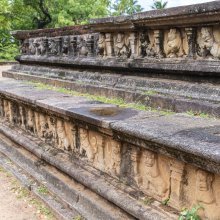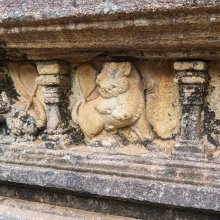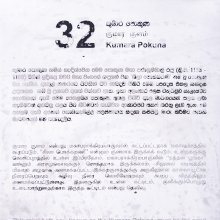Nandana, Nandanā, Nāndana, Namdana: 39 definitions
Introduction:
Nandana means something in Buddhism, Pali, Hinduism, Sanskrit, Jainism, Prakrit, the history of ancient India, Marathi. If you want to know the exact meaning, history, etymology or English translation of this term then check out the descriptions on this page. Add your comment or reference to a book if you want to contribute to this summary article.
Images (photo gallery)
In Hinduism
Vastushastra (architecture)
Source: Wisdom Library: Vāstu-śāstraNandana (नन्दन) refers to a type of temple (prāsāda) classified under the group named Triviṣṭapa, according to Samarāṅgaṇasūtradhāra chapter 49. The Triviṣṭapa group contains ten out of a sixty-four total prāsādas (temples) classified under five prime vimānas (aerial car/palace), which were created by Brahmā for as many gods (including himself). This group represents temples (e.g. Nandana) that are to be octangular in shape. The prāsādas, or ‘temples’, represent the dwelling place of God and are to be built in towns. The Samarāṅgaṇasūtradhāra is an 11th-century encyclopedia dealing with various topics from the Vāstuśāstra.
Nandana is mentioned in another list from the Samarāṅgaṇasūtradhāra chapter 56, being part of the group named Sāndhāna, containing 9 unique temple varieties.
Nandana is found in another list in the Samarāṅgaṇasūtradhāra, chapter 63, where it is listed in the group named Nāgara, containing 20 different prāsādas (temples/buildings).
Nandana is also mentioned as a classification of ‘temple’ in the Matsyapurāṇa which features a list of 20 temple types. This list represents the classification of temples in South-India.
Nandana is also listed in the Agnipurāṇa which features a list of 45 temple types. It is listed under the group named Vairāja, featuring square-shaped temples. This list represents a classification of temples in Nort-India.
Source: Wisdom Library: Vāstu-śāstraNandana (नन्दन) refers to a variety of maṇḍapa (halls attached to the temple), according to the Matsya-purāṇa (verses 270.1-30). The nandana-maṇḍapa is to be built with 30 pillars (stambha). The Matsyapurāṇa is one of the eighteen major purāṇas dating from the 1st-millennium BCE.
Accordingly (verse 270.15-17), “These maṇḍapas (e.g., nandana) should be either made triangular, circular, octagonal or with 16 sides or they are square. They promote kingdoms, victory, longevity, sons, wife and nourishment respecitvely. Temples of other shape than these are inauspicious.”
Source: Shodhganga: Elements of Art and Architecture in the Trtiyakhanda of the Visnudharmottarapurana (vastu)1) Nandana (नन्दन) is classified as a “tree beneficial for the construction of temples”, according to the Viṣṇudharmottarapurāṇa, an ancient Sanskrit text which (being encyclopedic in nature) deals with a variety of cultural topics such as arts, architecture, music, grammar and astronomy.—The eco-friendly suggestions of Viṣṇudharmottarapurāṇa are seen to protect the greenery and to balance a pollution free environment. [...] The architect is suggested to go to the forest to collect appropriate wood (e.g., from the Nandana tree) for temples in an auspicious day after taking advice from an astrologer. [...] According to the Viṣṇudharmottarapurāṇa, the woods of some particular trees remain beneficial for the construction of temples. At the time of cutting the trees [e.g., Nandana] one should clean the axe by smearing honey and ghee. After collecting the suitable wood from forest, the architect uses it according to his requirements and purposes.
2) Nandana (नन्दन) refers to a “six-storied” variety of the hundred types of Temples (in ancient Indian architecture).—It is quite difficult to say about a definite number of varieties of Hindu temples but in the Viṣṇudharmottarapurāṇa hundred varieties of temples have been enumerated. For example, Nandana. These temples are classified according to the particular shape, amount of storeys and other common elements, such as the number of pavilions, doors and roofs.

Vastushastra (वास्तुशास्त्र, vāstuśāstra) refers to the ancient Indian science (shastra) of architecture (vastu), dealing with topics such architecture, sculpture, town-building, fort building and various other constructions. Vastu also deals with the philosophy of the architectural relation with the cosmic universe.
Purana and Itihasa (epic history)
Source: archive.org: Puranic Encyclopedia1) Nandana (नन्दन).—Son of Hiraṇyakaśipu. Nandana who had been ruling over the Śveta island had obtained boons from Śiva and had become invincible. He ruled over the kingdom for ten thousand years and then attained Kailāsa and became a gaṇa of Śiva. (Śiva Purāṇa, Uttara Khaṇḍa, Chapter 2).
2) Nandana (नन्दन).—One of the two attendants given to Skandadeva by Aśvinīkumāras. (Mahābhārata Śānti Parva, Chapter 44).
3) Nandana (नन्दन).—A divine park in the world of devas (gods). Mention is made in Mahābhārata, Anuśāsana Parva, Chapter 25, Stanza 45, that those who had brought the organs of senses under control and who had not killed any living being, would be permitted to enter this park.
Source: Cologne Digital Sanskrit Dictionaries: The Purana Index1a) Nandana (नन्दन).—A Yakṣa: a son of Puṇyajanī and Maṇibhadra.*
- * Brahmāṇḍa-purāṇa III. 7. 122; Vāyu-purāṇa 69. 154.
1b) A son of Madhu.*
- * Brahmāṇḍa-purāṇa III. 70. 46; Vāyu-purāṇa 95. 46.
1c) A son of Śiva; father of Rantī and Rantipāla (Tanti and Tantipāla, Vāyu-purāṇa).*
- * Brahmāṇḍa-purāṇa III. 71. 149 and 192; Matsya-purāṇa 46. 27.
1d) A younger brother of Candrahāsa.*
- * Brahmāṇḍa-purāṇa IV. 29. 113.
1e) A temple with several peaks; the toraṇa is of 30 hastas.*
- * Matsya-purāṇa 269. 29, 33, 48.
1f) A disciple of Brahmā.*
- * Vāyu-purāṇa 22. 16.
1g) One of the eight nidhis of Kubera.*
- * Vāyu-purāṇa 41. 10.
1h) A brother of Vasudeva.*
- * Vāyu-purāṇa 96. 148.
1i) A son of Vanga and father of Sunandi.*
- * Viṣṇu-purāṇa IV. 24. 56.
1j) A pleasure garden of gods and Indra, noted for Pārijāta;1 visited by Kṛṣṇa and Satyabhāmā;2 in the Kailāsa on the north of Ilāvṛta destroyed by Daityas;3 on the banks of Mandākinī.4
- 1) Bhāgavata-purāṇa III. 23. 40; V. 16. 14; Matsya-purāṇa 38. 18; Vāyu-purāṇa 36. 11; 46. 4; 47. 3; 69. 136; 91. 6; 93. 69.
- 2) Bhāgavata-purāṇa X. [65 (v) 12-21]; [67 (v) 34].
- 3) Brahmāṇḍa-purāṇa II. 18. 4; III. 7. 102; 66. 6; IV. 9. 39; Matsya-purāṇa 183. 2; 212. 9; Viṣṇu-purāṇa II. 2. 25; V. 7. 66; 30. 30; 36. 12.
- 4) Matsya-purāṇa 121. 5; 131. 48; 133. 9.
2) Nandanā (नन्दना).—A river from the Pāriyātra hill (Ṛṣyavat).*
- * Brahmāṇḍa-purāṇa II. 16. 28; Matsya-purāṇa 114. 25.
Nandana (नन्दन) is a name mentioned in the Mahābhārata (cf. IX.44.34) and represents one of the many proper names used for people and places. Note: The Mahābhārata (mentioning Nandana) is a Sanskrit epic poem consisting of 100,000 ślokas (metrical verses) and is over 2000 years old.

The Purana (पुराण, purāṇas) refers to Sanskrit literature preserving ancient India’s vast cultural history, including historical legends, religious ceremonies, various arts and sciences. The eighteen mahapuranas total over 400,000 shlokas (metrical couplets) and date to at least several centuries BCE.
Dhanurveda (science of warfare)
Source: Wisdom Library: DhanurvedaNandana (नन्दन) refers to a weapon (name of a sword). It is a Sanskrit word defined in the Dhanurveda-saṃhitā, which contains a list of no less than 117 weapons. The Dhanurveda-saṃhitā is said to have been composed by the sage Vasiṣṭha, who in turn transmitted it trough a tradition of sages, which can eventually be traced to Śiva and Brahmā.

Dhanurveda (धनुर्वेद) refers to the “knowledge of warfare” and, as an upaveda, is associated with the Ṛgveda. It contains instructions on warfare, archery and ancient Indian martial arts, dating back to the 2nd-3rd millennium BCE.
Kavya (poetry)
Source: Wisdomlib Libary: KathāNandana (नन्दन) is the name of a big forest in Jambūdvīpa mentioned by Soḍḍhala in his Udayasundarīkathā. Jambūdvīpa is one of the seven continents (dvīpa) of Bhūrloka (earth). The soldiers were asked to seek Udayasundarī in these forests.
The Udayasundarīkathā is a Sanskrit work in the campū style, narrating the story of the Nāga princess Udayasundarī and Malayavāhana, king of Pratiṣṭhāna. Soḍḍhala is a descendant of Kalāditya (Śilāditya’s brother) whom he praises as an incarnation of a gaṇa (an attendant of Śiva).
Source: academia.edu: Gleanings from Atula’s MusikavamsaNandana (नन्दन) is the youngest son of King Rāmaghaṭa, according to the historical poem Mūṣikavaṃśa by Atula dealing with the royal lineage of North Kerala in roughly 1000 verses.—[...] [King Rāmaghaṭa] marries Suvarman’s daughter Bhadrasenā and installs his eldest son by her on the throne of Hehaya kingdom and returns to Mūṣika kingdom with his youngest son Nandana. Rāmaghaṭa retires to forest after making him the king.The pleasure loving Nandana was succeeded by a lineage, among whom were Ugra, Ugradhanvā, Siṃhasena, Candravarman, Bṛhatsuta and Ugrāśva. [...]

Kavya (काव्य, kavya) refers to Sanskrit poetry, a popular ancient Indian tradition of literature. There have been many Sanskrit poets over the ages, hailing from ancient India and beyond. This topic includes mahakavya, or ‘epic poetry’ and natya, or ‘dramatic poetry’.
Natyashastra (theatrics and dramaturgy)
Source: Wisdom Library: Nāṭya-śāstraNandana (नन्दन, “joy”) refers to a term to be used by women in love addressing their beloved during amorous union, according to the Nāṭyaśāstra chapter 24. Accordingly, “he who is high-born, patient, clever, kind, master of words and fit to be praised among women friends, is called ‘joy’ (nandana)”.

Natyashastra (नाट्यशास्त्र, nāṭyaśāstra) refers to both the ancient Indian tradition (shastra) of performing arts, (natya—theatrics, drama, dance, music), as well as the name of a Sanskrit work dealing with these subjects. It also teaches the rules for composing Dramatic plays (nataka), construction and performance of Theater, and Poetic works (kavya).
Jyotisha (astronomy and astrology)
Source: Wisdom Library: Brihat Samhita by VarahamihiraNandana (नन्दन) refers to the twenty-sixth of the sixty-year cycle of Jupiter, according to the Bṛhatsaṃhitā (chapter 8), an encyclopedic Sanskrit work written by Varāhamihira mainly focusing on the science of ancient Indian astronomy astronomy (Jyotiṣa).—Accordingly, “The five years of the next yuga are—1. Nandana, 2. Vijaya, 3. Jaya, 4. Manmatha, 5. Durmukha: during the first three years there will be happiness in the land; in Manmatha mankind will feel neither happy, nor miserable and in the year Durmukha they will feel miserable”.
Source: The effect of Samvatsaras: SatvargasNandana (नन्दन) refers to the twenty-sixth saṃvatsara (“jovian year)” in Vedic astrology.—The native who is born in the ‘samvatsara’ of ‘nandana’ gets water tank, well, dug and gets constructed Dharamshala (a lodge for the stay of pilgrims). He is always interested in donating grains as alms . He has pure heart and remains happy as he has wife and sons.
According with Jataka Parijata, the person born in the year nandana (2012-2013 AD) will delight every body, enjoy the favour of kings and will be conversant with the meaning of the sacred hymns in scripture.

Jyotisha (ज्योतिष, jyotiṣa or jyotish) refers to ‘astronomy’ or “Vedic astrology” and represents the fifth of the six Vedangas (additional sciences to be studied along with the Vedas). Jyotisha concerns itself with the study and prediction of the movements of celestial bodies, in order to calculate the auspicious time for rituals and ceremonies.
Vaishnavism (Vaishava dharma)
Source: Pure Bhakti: Arcana-dipika - 3rd EditionNandana (नन्दन) is the twenty-sixth of sixty years (saṃvatsara) in the Vedic lunar calendar according to the Arcana-dīpikā by Vāmana Mahārāja (cf. Appendix).—Accordingl, There are sixty different names for each year in the Vedic lunar calendar, which begins on the new moon day (Amāvasyā) after the appearance day of Śrī Caitanya Mahāprabhu (Gaura-pūrṇimā), in February or March. The Vedic year [viz., Nandana], therefore, does not correspond exactly with the Christian solar calendar year.

Vaishnava (वैष्णव, vaiṣṇava) or vaishnavism (vaiṣṇavism) represents a tradition of Hinduism worshipping Vishnu as the supreme Lord. Similar to the Shaktism and Shaivism traditions, Vaishnavism also developed as an individual movement, famous for its exposition of the dashavatara (‘ten avatars of Vishnu’).
General definition (in Hinduism)
Source: Wisdom Library: HinduismNandana (नन्दन) is a Sanskrit word referring to a dwelling place or resort of the celestial nymphs (apsaras). They live chiefly on earth around rivers or on mountains, as in the courts of all the gods.
In Buddhism
Theravada (major branch of Buddhism)
Source: Pali Kanon: Pali Proper NamesA devaputta who visited the Buddha at Savatthi and asked him questions regarding virtue, wisdom, etc. The Buddha answered them, and he went away satisfied. S.i.62.
Theravāda is a major branch of Buddhism having the the Pali canon (tipitaka) as their canonical literature, which includes the vinaya-pitaka (monastic rules), the sutta-pitaka (Buddhist sermons) and the abhidhamma-pitaka (philosophy and psychology).
Mahayana (major branch of Buddhism)
Source: Wisdom Library: Maha Prajnaparamita SastraNandana (नन्दन) or Nandanavana is the name of one of the four parks of the Sudarśana city according to appendix 8 of the 2nd century Mahāprajñāpāramitāśāstra (chapter XIV).—The Trāyastriṃśa gods with Śakra as king live in the city of Sudarśana on the summit of Mount Meru. This city has four parks (viz., Nandana).
According to the Tch’ang a han, “Why is it called Pāruṣya-vana? Because when one enters it, one’s thoughts (chen t’i) become harsh (paruṣa)… Why is it called Nanadana-vana? Because when one enters it, one is happy and joyful”.
According to the P’i p’o cha, “In the Pāruṣya-vana, when the gods want to go to war, armor and weapons appear according to their needs… In the Nanadana-vana, all kinds of marvels and joys are gathered and they go from one to another without getting tired”.

Mahayana (महायान, mahāyāna) is a major branch of Buddhism focusing on the path of a Bodhisattva (spiritual aspirants/ enlightened beings). Extant literature is vast and primarely composed in the Sanskrit language. There are many sūtras of which some of the earliest are the various Prajñāpāramitā sūtras.
Tibetan Buddhism (Vajrayana or tantric Buddhism)
Source: Wisdom Library: Tibetan BuddhismNandana (नन्दन) is the name of a Śrāvaka mentioned as attending the teachings in the 6th century Mañjuśrīmūlakalpa: one of the largest Kriyā Tantras devoted to Mañjuśrī (the Bodhisattva of wisdom) representing an encyclopedia of knowledge primarily concerned with ritualistic elements in Buddhism. The teachings in this text originate from Mañjuśrī and were taught to and by Buddha Śākyamuni in the presence of a large audience (including Nandana).

Tibetan Buddhism includes schools such as Nyingma, Kadampa, Kagyu and Gelug. Their primary canon of literature is divided in two broad categories: The Kangyur, which consists of Buddha’s words, and the Tengyur, which includes commentaries from various sources. Esotericism and tantra techniques (vajrayāna) are collected indepently.
In Jainism
General definition (in Jainism)
Source: Wisdom Library: Jainism1) Nandana (नन्दन) is the name of a caitya (‘shrine’, dedicated to a deity), located in the town Mokā, according to the Bhagavatī-sūtra, also known as The Vyākhyāprajñapti (“Exposition of Explanations”). The Bhagavatī-sūtra is the largest of twelve Jain āgamas and was composed by Sudharmāsvāmī in the 6th century.
2) Nandana (नन्दन) is the name of a terrace grove situated 500 yojanas from Bhadraśālā, which is located at the base of mount Meru, which lies at in the center of Jambudvīpa. Jambūdvīpa sits at the centre of madhyaloka (‘middle world’) is the most important of all continents and it is here where human beings reside.
Source: archive.org: Personal and geographical names in the Gupta inscriptions (jainism)Nandana (नन्दन) is a Prakrit ending for deriving proper personal names, mentioned as an example in the Aṅgavijjā chapter 26. This chapter includes general rules to follow when deriving proper names. The Aṅgavijjā (mentioning nandana) is an ancient treatise from the 3rd century CE dealing with physiognomic readings, bodily gestures and predictions and was written by a Jain ascetic in 9000 Prakrit stanzas.
Source: archive.org: Trisastisalakapurusacaritra1) Nandana (नन्दन) is a half-way garden on Meru, according to chapter 1.1 [ādīśvara-caritra] of Hemacandra’s 11th century Triṣaṣṭiśalākāpuruṣacaritra: an ancient Sanskrit epic poem narrating the history and legends of sixty-three illustrious persons in Jainism.—Accordingly, “[...] they [viz., Vajranābha and others] had the art of flying with their legs by which they were able to reach Rucakadvīpa in one jump. [...] then turning, they were able to go to Nandana with one jump and with a second to the place of the first jump”.
2) Nandana (नन्दन), the son of Jayantī, is one of the nine white Baladevas, according to chapter 1.6.
3) Nandana (नन्दन) or Nandanagiri is the name of an ancient Muni, according to chapter 5.2 [śāntinātha-caritra].
4) Nandana (नन्दन) refers to one of the sons of Vijayasenā and king Sāgaradatta from Padminīkhaṇḍa, according to chapter 5.4 [śāntinātha-caritra].
5) Nandana (नन्दन) refers to one of the Kapis fighting in Rāma’s army, according to the Jain Ramayana and chapter 7.7 [The killing of Rāvaṇa].—Accordingly, “[...] When the battle had been going on for a long time, the army of the Rākṣasas was broken by the Vānaras like a forest by winds. [...] [Nandana, ...] and other Kapis fought with Rākṣasas separately, leaping up and falling down, like cocks fighting with cocks. [...] Nandana killed the Rākṣasa Jvara. [...] Then the soldiers of Rāma and Rāvaṇa returned, purifying their own men, killed and unkilled”.
Source: Encyclopedia of Jainism: Tattvartha Sutra 3: The Lower and middle worldsNandana (नन्दन) or Nandanavana is the name of a forest situated on mount Sumeru, which lies at the centre of Jambūdvīpa: the tree enveloping the continent of Jambūdvīpa: the first continent of the Madhya-loka (middle-word), according to the 2nd-century Tattvārthasūtra 3.10.—There are four forests (vana) on Sumeru Mount. They are called Bhadraśāla, Nandanavana, Saumanasavana and Pāṇḍukavana. The first forest lies at the foot of the mountain and the rest in its platform. How many Jina temples are there in the four forests? There are four Jina temples in four directions in each forest for a total of 16 temples on the mount.

Jainism is an Indian religion of Dharma whose doctrine revolves around harmlessness (ahimsa) towards every living being. The two major branches (Digambara and Svetambara) of Jainism stimulate self-control (or, shramana, ‘self-reliance’) and spiritual development through a path of peace for the soul to progess to the ultimate goal.
India history and geography
Source: archive.org: Ceylon Branch of the Royal Asiatic Society 1963Nandana is the name of a part that existed within Citadel (royal enclosing) of Polonnaruva (Polonnaruwa), Ceylon (Sri Lanka).—On ground adjoining the Royal Enclosure, Parakkamabāhu laid out the Nandana Park in which were many varieties of fruit and flowering trees and the following structures:—(i) A Bath House with shower-baths and a (?) fountain; (ii) a Pavilion with pillars of sandalwood, containing an octagonal maṇḍapa resembling an ear-ornament; (iii) a maṇḍapa which had “the charm of a wreath of serpentine wanderings”; (iv) the Silāpokkharaṇī, now called Kumārapokuṇa; (v) the Nandāpokkharaṇī; (vi) a Pond holding perfumed water; (vii) the Vasanta cave; (viii) the Maṅgalapokkharaṇī. Later, the Nandana Park was extended, re-named Lakkhuyyāna and made over to the Saṅgha: two ponds below hollow rocks were constructed for the monks to bathe in.

The history of India traces the identification of countries, villages, towns and other regions of India, as well as mythology, zoology, royal dynasties, rulers, tribes, local festivities and traditions and regional languages. Ancient India enjoyed religious freedom and encourages the path of Dharma, a concept common to Buddhism, Hinduism, and Jainism.
Languages of India and abroad
Pali-English dictionary
Source: BuddhaSasana: Concise Pali-English Dictionarynandana : (nt.) rejoicing; name of a garden in Indra's city. || nandanā (f.), rejoicing.
Source: Sutta: The Pali Text Society's Pali-English DictionaryNandanā, (f.) (Sk. nandanā) rejoicing, delight, pleasure S. I, 6=Sn. 33. (Page 346)

Pali is the language of the Tipiṭaka, which is the sacred canon of Theravāda Buddhism and contains much of the Buddha’s speech. Closeley related to Sanskrit, both languages are used interchangeably between religions.
Marathi-English dictionary
Source: DDSA: The Molesworth Marathi and English Dictionarynandana (नंदन).—m (S) A son. 2 n Indra's pleasure-ground, Elysium. 3 S Delighting, making pleased or happy.
Source: DDSA: The Aryabhusan school dictionary, Marathi-Englishnandana (नंदन).—m A son. n Indra's pleasure- ground. Delighting.
Marathi is an Indo-European language having over 70 million native speakers people in (predominantly) Maharashtra India. Marathi, like many other Indo-Aryan languages, evolved from early forms of Prakrit, which itself is a subset of Sanskrit, one of the most ancient languages of the world.
Sanskrit dictionary
Source: DDSA: The practical Sanskrit-English dictionaryNandana (नन्दन).—a. [nand-lyu] Delighting, pleasing, gladdening; Ś.7; सोऽयमद्य मकरन्दनन्दनो जीवलोकतिलकः प्रलीयते (so'yamadya makarandanandano jīvalokatilakaḥ pralīyate) Mālatīmādhava (Bombay) 9.21.
-naḥ 1 A son; Y.1.174; R.3.41.
2) A frog.
3) An epithet of Viṣṇu.
4) Name of Śiva.
5) Name of twentysixth year (saṃvatsara).
-nā A daughter.
-nam 1 Name of the garden of Indra, the Elysium; हन्त गच्छत भद्रं वो नन्दने पश्यत स्थितम् (hanta gacchata bhadraṃ vo nandane paśyata sthitam) Mahābhārata (Bombay) 3.142.59; R.8.95; पुरीमवस्कन्द लुनीहि नन्दनं मुषाण रत्नानि हरामराङ्गनाः (purīmavaskanda lunīhi nandanaṃ muṣāṇa ratnāni harāmarāṅganāḥ) Śiśupālavadha 1.51.
2) Rejoicing, being glad.
3) joy.
--- OR ---
Nāndana (नान्दन).—a. Gladdening, pleasing; सैषा विदृतिर्नाम द्वास्तदेतन्नान्दनम् (saiṣā vidṛtirnāma dvāstadetannāndanam) Ait. Up.3.12.
-nam A pleasure-garden, paradise.
Source: Cologne Digital Sanskrit Dictionaries: Edgerton Buddhist Hybrid Sanskrit DictionaryNandana (नन्दन).—(1) name of a Śākyan, son of Śukrodana (compare Nanda 1), who retired from the world: Mahāvastu iii.177.1; (2) name of a yakṣa: Mahā-Māyūrī 236.26; (3) name of a nāga-king: Mahā-Māyūrī 246.25, 29; (4) nt., name of a mythical city: Divyāvadāna 602.2; Avadāna-śataka i.201.12.
Source: Cologne Digital Sanskrit Dictionaries: Shabda-Sagara Sanskrit-English DictionaryNandana (नन्दन).—mfn.
(-naḥ-nā-naṃ) Delighting, rejoicing, making pleased or happy. m.
(-naḥ) 1. A son. 2. A frog. 3. Vishnu. n.
(-naṃ) Indra'S pleasure ground, elysium. 2. A species of the Dhritti metre. f.
(-nā) A daughter. E. nadi to be or make happy, affix lyu .
Source: Cologne Digital Sanskrit Dictionaries: Benfey Sanskrit-English DictionaryNandana (नन्दन).—[nand + ana], I. adj., f. nā, Gladdening, Mahābhārata 3, 11073. Ii. m. 1. A son, [Yājñavalkya, (ed. Stenzler.)] 1, 274. 2. Epithet of Viṣṇu and Śiva, Mahābhārata 13, 7005; 1189. 3. A certain plant, [Suśruta] 2, 251, 19. 4. A proper name, Mahābhārata 9, 2540. 5. The name of a mountain, [Bhāgavata-Purāṇa, (ed. Burnouf.)] 5, 20, 21. Iii. n. The pleasure-ground of the gods, especially of Indra, [Indralokāgamana] 2, 3.
Source: Cologne Digital Sanskrit Dictionaries: Cappeller Sanskrit-English DictionaryNandana (नन्दन).—[adjective] gladdening, making happy; [masculine] son, descendant of (—°), [Name] of [several] myth. beings & of a minister; [feminine] ā daughter; [neuter] gladdening, joy, bliss, [Name] of Indra's grove.
--- OR ---
Nāndana (नान्दन).—[neuter] pleasure-ground, paradise.
Source: Cologne Digital Sanskrit Dictionaries: Aufrecht Catalogus Catalogorum1) Nandana (नन्दन) as mentioned in Aufrecht’s Catalogus Catalogorum:—a contemporary of Maṅkha. Śrīkaṇṭhacarita 25, 25.
2) Nandana (नन्दन):—Śrāddhacandrikā. Sb. 148.
3) Nandana (नन्दन):—son of Lakṣmaṇa, a friend of Vīramalla: Mahābhārataṭīkā. Burnell. 184^b (Mokṣadharma). Nandinī Mānavadharmaśāstravyākhyāna. Burnell. 126^a. According to the Bombay edition of 1886, he was a younger brother of Lakṣmaṇa (Lakṣmaṇānuja, not Lakṣmaṇātmaja).
Source: Cologne Digital Sanskrit Dictionaries: Monier-Williams Sanskrit-English Dictionary1) Nandana (नन्दन):—[from nand] mf(ā)n. (the initial n is not changeable to ṇ [gana] kṣubhnādi) rejoicing, gladdening (cf. daka), [Mahābhārata; Varāha-mihira; Pañcatantra]
2) [v.s. ...] m. a son, [Yājñavalkya; Mahābhārata; Kāvya literature] etc. (ifc. also naka, [Mahābhārata])
3) [v.s. ...] a frog (cf. daka), [cf. Lexicographers, esp. such as amarasiṃha, halāyudha, hemacandra, etc.]
4) [v.s. ...] m. a kind of poisonous plant, [Suśruta] (also f. [Scholiast or Commentator])
5) [v.s. ...] m. a [particular] form of temple, [Varāha-mihira]
6) [v.s. ...] (in music) a kind of measure
7) [v.s. ...] Name of Viṣṇu or Śiva, [Mahābhārata]
8) [v.s. ...] of an attendant of Skanda, [ib.]
9) [v.s. ...] of a Siddha, [Bhāgavata-purāṇa]
10) [v.s. ...] of a, [Buddhist literature] deity, [Lalita-vistara] ([varia lectio] nanda)
11) [v.s. ...] (with Jainas) of the 7th of the 9 white Balas
12) [v.s. ...] of a mountain, [Purāṇa]
13) [v.s. ...] of sub voce authors (also -bhaṭṭācārya and -miśra), [Catalogue(s)]
14) [v.s. ...] of the 26th year in a Jupiter cycle of 60 years, [Varāha-mihira]
15) Nandanā (नन्दना):—[from nandana > nand] f. daughter (cf. kula-)
16) Nandana (नन्दन):—[from nand] n. gladdening or gladness, [Mahābhārata] a divine garden, ([especially]) Indra’s paradise, [Mahābhārata; Kāvya literature] etc.
17) [v.s. ...] Name of a sword, [Rāmāyaṇa] (cf. daka)
18) [v.s. ...] Name of a metre, [Colebrooke]
19) Nāndana (नान्दन):—[from nānda] n. (√nand or nandana) a pleasure garden, paradise, [Sāma-veda; Aitareya-upaniṣad]
Source: Cologne Digital Sanskrit Dictionaries: Yates Sanskrit-English DictionaryNandana (नन्दन):—(naḥ) 1. m. A son; a frog; Vishnu. f. A daughter. n. Indra's elysium. a. Rejoicing.
Source: DDSA: Paia-sadda-mahannavo; a comprehensive Prakrit Hindi dictionary (S)Nandana (नन्दन) in the Sanskrit language is related to the Prakrit words: Ṇaṃdaga, Ṇaṃdaṇa, Ṇaṃdaṇā.
[Sanskrit to German]
Sanskrit, also spelled संस्कृतम् (saṃskṛtam), is an ancient language of India commonly seen as the grandmother of the Indo-European language family (even English!). Closely allied with Prakrit and Pali, Sanskrit is more exhaustive in both grammar and terms and has the most extensive collection of literature in the world, greatly surpassing its sister-languages Greek and Latin.
Prakrit-English dictionary
Source: DDSA: Paia-sadda-mahannavo; a comprehensive Prakrit Hindi dictionary1) Ṇaṃdaṇa (णंदण) in the Prakrit language is related to the Sanskrit word: Nandana.
2) Ṇaṃdaṇā (णंदणा) also relates to the Sanskrit word: Nandanā.
Prakrit is an ancient language closely associated with both Pali and Sanskrit. Jain literature is often composed in this language or sub-dialects, such as the Agamas and their commentaries which are written in Ardhamagadhi and Maharashtri Prakrit. The earliest extant texts can be dated to as early as the 4th century BCE although core portions might be older.
Kannada-English dictionary
Source: Alar: Kannada-English corpusNaṃdana (ನಂದನ):—
1) [noun] the act of giving great joy or pleasure to another.
2) [noun] delight; happiness; joy.
3) [noun] one’s son.
4) [noun] the garden of heaven.
5) [noun] any garden, pleasure-grove, in gen.
6) [noun] the twenty sixth year in the cycle of sixty years.
7) [noun] Śiva.
8) [noun] Viṣṇu.
9) [noun] (dance.) a kind of musical composition.
--- OR ---
Nāṇdāṇa (ನಾಣ್ದಾಣ):—[noun] the region of sex-organs.
Kannada is a Dravidian language (as opposed to the Indo-European language family) mainly spoken in the southwestern region of India.
See also (Relevant definitions)
Starts with (+7): Nandana bhatta, Nandana mishra, Nandana Parivena, Nandana Pokkharani, Nandana Sutta, Nandana Vagga, Nandanadruma, Nandanagara, Nandanagiri, Nandanaja, Nandanaka, Nandanakanana, Nandanamala, Nandananaga, Nandanandana, Nandanandanashtaka, Nandanandani, Nandanandini, Nandananripa, Nandananripakatha.
Ends with (+116): Abdhinamdana, Abhinandana, Aditinandana, Agnisimhanandana, Ahalyanandana, Ahinamdana, Amritanandana, Anabhinandana, Anandana, Anandanandana, Arinandana, Arkanandana, Aryamanandana, Ashvasenanripanandana, Asipatranamdana, Balinandana, Bhaganandana, Bhanandana, Bhandiravananandana, Bhatta sunandana.
Full-text (+320): Nandanavana, Aditinandana, Devakinandana, Kashyapanandana, Raghunandana, Shambhunandana, Arkanandana, Daivakinandana, Kausalyanandana, Parvatinandana, Arinandana, Balinandana, Gadhinandana, Nandanadruma, Nandanamala, Shakranandana, Shrinandana, Nandanandana, Varnabhidhana, Yadunandana.
Relevant text
Search found 86 books and stories containing Nandana, Nandanā, Nāndana, Namdana, Ṇaṃdaṇa, Ṇandaṇa, Ṇaṃdaṇā, Ṇandaṇā, Naṃdana, Nāṇdāṇa; (plurals include: Nandanas, Nandanās, Nāndanas, Namdanas, Ṇaṃdaṇas, Ṇandaṇas, Ṇaṃdaṇās, Ṇandaṇās, Naṃdanas, Nāṇdāṇas). You can also click to the full overview containing English textual excerpts. Below are direct links for the most relevant articles:
Garga Samhita (English) (by Danavir Goswami)
Verses 2.10.11-13 < [Chapter 10 - Description of Śrī Kṛṣṇa’s Herding the Cows]
Verse 3.2.10 < [Chapter 2 - The Great Festival of Śrī Girirāja]
Verse 5.19.22 < [Chapter 19 - The Festival on Śrī Kṛṣṇa Return]
Brihad Bhagavatamrita (commentary) (by Śrī Śrīmad Bhaktivedānta Nārāyana Gosvāmī Mahārāja)
Verse 2.4.110 < [Chapter 4 - Vaikuṇṭha (the spiritual world)]
Verse 1.7.122 < [Chapter 7 - Pūrṇa (pinnacle of excellent devotees)]
Verse 1.1.70-72 < [Chapter 1 - Bhauma (the earthly plane)]
Maha Prajnaparamita Sastra (by Gelongma Karma Migme Chödrön)
Appendix 8 - The four gardens of the Trāyastriṃśa gods < [Chapter XIV - Emission of rays]
Act 5.4: The softening of the earth makes beings joyful < [Chapter XIV - Emission of rays]
Appendix 1 - The temptation of Anuruddha (visit of the Manāpakāyikā-devatās) < [Chapter XVII - The Virtue of Generosity]
Sahitya-kaumudi by Baladeva Vidyabhushana (by Gaurapada Dāsa)
Text 7.80 < [Chapter 7 - Literary Faults]
Text 4.21 < [Chapter 4 - First-rate Poetry]
Text 10.133 < [Chapter 10 - Ornaments of Meaning]
Bhakti-rasamrta-sindhu (by Śrīla Rūpa Gosvāmī)
Verse 3.2.151 < [Part 2 - Affection and Service (dāsya-rasa)]
Verse 3.4.37 < [Part 4 - Parenthood (vātsalya-rasa)]
Verse 2.5.119 < [Part 5 - Permanent Ecstatic Mood (sthāyī-bhāva)]
Related products




